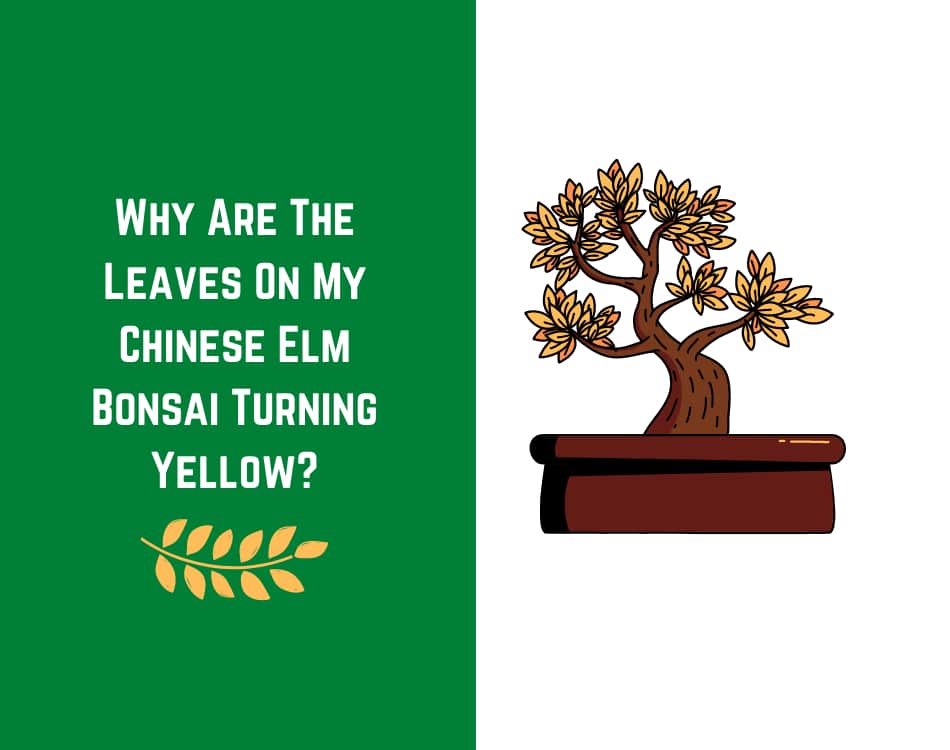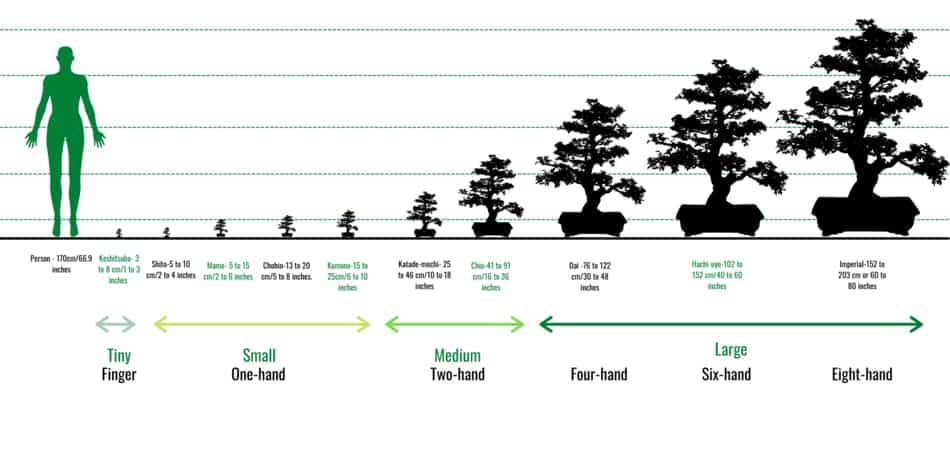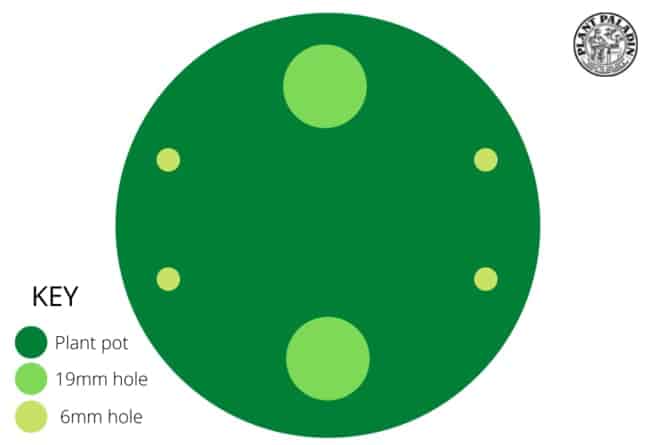This website is supported by its readers. If you click one of my links I may earn a commission. I am also a participant in the Amazon affiliates program and I will also earn a commission from qualified purchases.

Chinese elms are one of the most common types of bonsai trees sold and are perfect as beginner bonsai trees. It’s the very reason why I decided to opt for one for my first bonsai tree. That being said, a problem I noticed recently was that one of my Chinese elm leaves started to turn yellow. Should this be a cause for concern? Or just an amateur bonsai owner overthinking?
Underwatering, overwatering, leaving Chinese elm at a cold temperature, mineral deficiencies and stress are all reasons as to why Chinese elms leaves turn yellow. Chinese elms can be classified as partially evergreen so their leaves may also go yellow naturally during the fall and winter months.
So when are Chinese elm leaves going yellow a cause for concern and what can you do to stop your Chinese elm leaves from turning yellow?
Keep reading to find out more!
Just a quick heads up, over the past three years of running Plantpaladin, hundreds of people have asked for product recommendations. As such, You can find my favorite indoor bonsai tree here (link takes you to Bonsaiboy), my favorite outdoor bonsai tree (link takes you to Bonsaiboy), or have a look at all the products I recommend here.
Chinese elm bonsai yellow leaves
Chinese elms are fantastic trees to get started with bonsai.
They are super durable, can withstand most environments (according to the USDA they are perfect in zones 5-10), grow rapidly, and work well in both indoor and outdoor conditions.
In other words, it’s incredibly difficult to go wrong as a beginner with Chinese elm bonsai.
That being said, a common challenge these plants can sometimes have is the yellowing of leaves.
This is often caused by one or many of the following reasons:
- The natural cycle of the tree
- Underwatering
- Overwatering
- Poor drainage
- Cold temperature
- Mineral deficiencies
- Lack of light
- Insect infestation
- Stress
Let’s explore these individually in more detail below:

The natural cycle of the tree
Often, when bonsai owners worry that their leaves are turning yellow all of a sudden, it is more often than not a new bonsai owner that is experiencing their first fall or winter.
You see Chinese elm whilst not strictly being evergreen they are not fully deciduous either.
This means that some of the properties that evergreen tree species such as pine plants have Chinese elms also have.
Mainly, leaves turning yellow in colder or winter environments.
With Chinese elms, this can sometimes be well into the winter period past the fall.
Often they may also fall off however, they will often replenish and bring back stronger leaves.
It is important to note however that if your bonsai does begin to shoot new leaves and these start to yellow then there might be a wider cause for concern.
Underwatering
One of the biggest reasons for Chinese elm leaves turning yellow is that you may just be under watering your plant.
This occurs quite a lot in smaller-sized bonsai such as Keshitsubo or Shito (see the image below for fingertip or small-sized bonsai) which can easily dry out.

Not having enough water in your plant will mean it cannot process the nutrients throughout the tree or become inefficient at photosynthesis.
This can also lead to drooping leaves or leaves which turn yellow as a way of compensating and saving energy for the lack of water.
To ensure your plant gets enough water, check your Chinese elm daily for dry soil.
If the soil is dry then feel free to water until the water comes out of the drainage holes in your pot.
Using something like sphagnum moss for bonsai can also help keep your Chinese elms moist if you put it in the soil mix.
Overwatering
Chinese elms love water and so it is a lot more common to underwater than overwater a bonsai.
That being said, watering your plant too often can cause root rot, which will stop the process of nutrients to your Chinese elm, in turn causing the leaves to wilt and eventually turn yellow.
What’s even worse is that doing so will make your bonsai more susceptible to things like insect infestation, and mold-based diseases to spread.
To solve this check your Chinese elms daily and ensure that you only water your plant when the soil is dry to the touch.
If the soil is moist then avoid it.
I’d also recommend using soil amendment with something like granite, pebbles, perlite, or even stones as a way to pass the water easily ensuring your bonsai does not hold onto moisture.
Poor drainage
Similar to the point above, one of the major reasons why overwatering can cause your Chinese elm leaves to turn yellow is that your pots just don’t have enough holes in them.
Most bonsai trees as a minimum need two penny-sized holes, with this getting larger depending on the size of the bonsai.
Failure to have a plant pot then that allows for proper aeration, holds onto moisture but also lets excessive moisture fall out will cause your Chinese elms to be over-watered once again and in turn, have its leaves turn yellow.

Cold temperature
Chinese elms are very versatile when it comes to temperature, usually being able to survive in the summer months outdoors in between 60-70 degrees Fahrenheit.
Even in most climates, Chinese elms can survive in cold climates however if you live in exceptionally cold climates, (such as zones 1-4 in the USDA hardiness zone) then your Chinese elm may start to suffer.
The cold winters and lack of light can ensure your Chinese elms become less efficient at photosynthesis which can lead to some of its leaves turning yellow.
If you keep your Chinese elm bonsai outdoors during the winter you can also dry out your plant leading to a lot of the same problems that under watering your bonsai will have.
To avoid this, simply keep your Chinese elms indoors where you can manage the temperature.
Alternatively, if you have no space indoors consider building a cold frame or winterizing your bonsai to ensure its survival in the harsh winter months.
Mineral deficiencies
A lot of Chinese elms are manufactured and grown in large nurseries and then shipped out for bonsai enthusiasts like me and you to buy.
Because of this, a lot of them get used to quality fertilizer and plant food when they are in the manufacturing process only to have this taken away when we purchase them.
This can cause some mineral deficiencies in weaker plants and cause the leaves of Chinese elms to turn yellow.
This can be especially common if using an inorganic soil mix with things like akadama as opposed to a soil mix that contains natural elements such as cactus soil.
Luckily this can usually be easily counter by over the counter bonsai fertilizer, just ensure whatever fertilizer you opt for has the following:
- Plenty of calcium ( trees need this year-round)
- Magnesium
- Sulfur
- A lot of other micronutrients
A good fertilizer mix typically has calcium, magnesium, and sulfur at a mix of 12-1-4.
Lack of light
Chinese elms, like all bonsai species, need a lot of light – more than you might think.
Leaving your Chinese elms out for 3 to 4 hours during the summer months is likely not going to be enough so aim to keep them outside for as long as possible.
I found 8 hours works best for me.
Without sunlight, your bonsai will not be able to eat via photosynthesis and so one of the first things it will remove as an energy-saving method will be its leaves, causing them to turn yellow, then brown, and eventually fall off.
Now if in the summer months you have a washout with a rainy summer, I’d recommend investing in a UV light.
Whilst it won’t be as good as the natural sunlight, it does give your plant the energy light it needs, stopping your Chinese elm leaves from turning yellow.
Insect infestations
Bugs are part of the parcel of being a bonsai owner.
Some pests however can directly cause Chinese elm leaves to turn yellow.
Mites such as scale in particular latch onto the bottom of bonsai leaves, absorbing the dew and eating into the cell membrane of the leaves which can cause leaves to turn yellow and fall off.
A solution of pesticide or natural insect repellent made up of rubbing alcohol, washing up liquid, and water in a spray bottle usually works best but to read up more on how to remove pests of every variety – check out this post here.
Stress
Finally, stress can also cause your Chinese elm leaves to turn yellow.
If you are excessively pruning your tree or pruning them during the winter months, this will give your plant excessive stress and can cause some of the leaves to turn yellow.
The same goes if you are trying to jin a bonsai or use other deadwood techniques which, if done incorrectly can damage the flow of nutrients to your tree further causing Chinese elm leaves to fall off.
To ensure your tree is not stressed then:
- Only prune and trim your tree when it is healthy but in the dormant stage
- Only use clean cutting tools to avoid passing on fungal infections
- Do not prune trees when your first get them, give them time to settle into their new climate and pots
- Only wire your trees when they are in the growing stage
When should you not worry about Chinese elm leaves turning yellow?
If Chinese elm leaves turn yellow during the fall or winter months, this is not a cause for concern. Instead, it is the natural process Chinese elms go through. If you prune your tree and the fresh leaves grow back yellow, this is a cause for concern and a thorough diagnosis should take place.
How to stop Chinese elm leaves from turning yellow
So because yellow leaves on Chinese elms can be caused by multiple different factors, I thought I would put together a table below highlighting what to do.
Consider this a bit of a checklist to go through one by one and hopefully you should be apple to reverse the yellow leaves
| Cause of yellow leaves | How to solve |
| Underwatering | Ensure you water if the soil is dry to the touch. Check the soil every day and water until the water drains from the pot |
| Overwatering | Ensure you water if the soil is dry to the touch. Check the soil every day and water until the water drains from the pot |
| Poor drainage | Ensure your pot has at least two penny-sized holes in its pot. For larger Chinese elms ensure you have many smaller-sized holes too. |
| Cold temperature | Winterize your bonsai, keep your bonsai indoors where you can regulate temperature, or create a bonsai cold frame. |
| Mineral deficiencies | Invest in fertilizer with plenty of calcium, magnesium, and sulfates |
| Lack of light | Keep your Chinese elm in the sun for 8+ hours per day or invest in a UV light |
| Insect infestation | Use a mix of one tablespoon=n of liquid soap, with 70% rubbing alcohol and 30oz of water. Mix in a solution and spray your Chinese elm thoroughly |
| stress | Only prune your tree when dormant, only wire your Chinese elm when it is growing. |
What do the experts say?
I also asked a member of the botanical gardens on my last visit about yellow leaves and this is what they said:
“Yellow leaves on plants are most often a result of underwatering – I find if your plant gets enough water it makes a huge difference. It doesn’t matter if it’s a bonsai or not”
Wrapping things up
To finalize, yellow leaves on a Chinese elm bonsai are caused by multiple factors, the most common of which are watering your plant too much or not enough, not getting adequate light, and mineral deficiencies.
If spotted early enough this can be reversed.
In most situations, however, Chinese elms will get yellow leaves naturally during the winter months as it goes through their natural cycle.
My top picks for the gear you will need!
So like I mentioned earlier, over the past three years of running PlantPaladin, hundreds of people have asked me for my recommendations on the best bonsai gear on the market.
Having spent thousands of dollars on bonsai items these past few years and tested at least 100 bonsai-specific products, I’ve listed my favorite products below – All of which I highly recommend and think you can get great value.
They can purchase directly by clicking the link to take them to Amazon.
Bonsai Tool Set: One of the significant challenges I’ve had is finding a toolset that was not only durable but didn’t break the bank. SOLIGT has recently developed a fantastic bonsai tool set that covers all the tools you need to trim, prune, and repot your trees. – You can grab it here.
Complete Bonsai Set: Many of you will want to grow your bonsai trees entirely from scratch, but finding the varicose seeds, pots, and other items in one place can be challenging. Leaves and Sole then have created a complete bonsai set that I’ve personally used that ticks all the boxes. You can grab it here.
Bonsai wire: The number of times I’ve run out of wire for my bonsai or purchased cheap bonsai wire that doesn’t do the job is embarrassing for me to admit. After a lot of trial and error, I found that using Hotop’s aluminum bonsai wire is one of the best options on the market. This can easily be used for both indoor and outdoor bonsai. You can grab it here.
This post was written by Fehed Nicass who has been passionate about bonsai for over 2 years. He currently resides in the UK.
